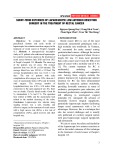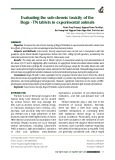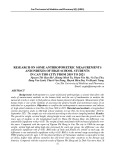
Can Tho Journal of Medicine and Pharmacy 9(5) (2023)
9
EFFICACY OF INTRATHECAL MORPHINE AFTER
LAPAROSCOPIC SURGERY FOR COLORECTAL CANCER AT
CAN THO UNIVERSITY OF MEDICINE AND PHARMACY
HOSPITAL
Vu Van Kim Long*, Nguyen Thi Tuyet Minh,
Vo Nguyen Hong Phuc, Tran Van Dang, Le Vu Linh
Can Tho University of Medicine and Pharmacy
* Corresponding author: vvklong@ctump.edu.vn
ABSTRACT
Background: There have been many studies in using intrathecal morphine order to reduce
pain after obstetrics and gynecological surgeries, abdominal surgeries and orthopedic surgeries.
These studies have shown that intrathecal morphine is very effective for pain relief after surgery.
However, intrathecal morphine also has side effects especially in obstetric and gynecological
surgeries such as pruritus, postoperative nausea and vomiting, and delayed respiratory depression.
Although postoperative analgesia with intrathecal morphine has been widely used in obstetrics and
gynecological surgeries, orthopedic surgeries, there have been very few studies on postoperative
pain relief with intrathecal morphine for colorectal surgery. Laparoscopic colorectal surgery
requires multimodal analgesia, so using intrathecal morphine to reduce postoperative pain in this
surgery is essential in clinical practice. Therefore, studying the effectiveness of intrathecal morphine
in this surgery is necessary, so we conducted this study. Objectives: To assess the effectiveness of
analgesic and side effects of intrathecal morphine after laparoscopic colorectal surgery. Materials
and Methods: This was a descriptive, cross-sectional study, including 63 patients undergoing
laparoscopic colorectal cancer surgery with intrathecal morphine before general anesthesia. The
degree of analgesia was assessed based on VAS. The postoperative side effects observed were
postoperative nausea and vomiting, respiratory depression, and pruritus. Results: The analgesic
effect at rest and on slight movement was 95.2%, and 88.9% respectively with VAS ≤ 3. The side
effects were postoperative nausea and vomiting (6.3%), and pruritus (1.6%), both postoperative
nausea and vomiting and pruritus (3.2%). In conclusion, 300µg intrathecal morphine showed a
safe and positive analgesic effect for laparoscopic colorectal cancer surgery.
Keywords: intrathecal morphine, laparoscopic colorectal surgery, analgesia, pain relief, VAS.
I. INTRODUCTION
Presently, pain management after surgery is absolutely necessary for clinical
practice for patient satisfaction. Intrathecal morphine has demonstrated its role. There have
been many studies in clinical practice on intrathecal morphine for laparotomy and
laparoscopic surgery such as obstetric and gynecological, urological, hepatobiliary-
pancreatic, orthopedic, and even thoracic surgery. The results showed that analgesia was
effective in the first 24 hours post ‒ operation and few patients required more medicines for
pain relief [3], [10], [11], [12].
Globally, the recommended dose for intrathecal morphine ranges from 50 to 500µg.
Many studies have also indicated that a dose of 300µg had positive effects with a long
duration of pain relief and similar side effects to lower doses. However, the concerns about
side effects of intrathecal morphine such as postoperative nausea and vomiting, pruritus,
and delayed respiratory depression have prevented the majority of Vietnamese






![Study on toxicities of 10β-[(2'β-hydroxy-3'- imidazol) propyl] deoxo-artemisinin (32) in reproductive and developmental progresses of mice](https://cdn.tailieu.vn/images/document/thumbnail/2025/20250228/viinuzuka/135x160/8021740737116.jpg)

































